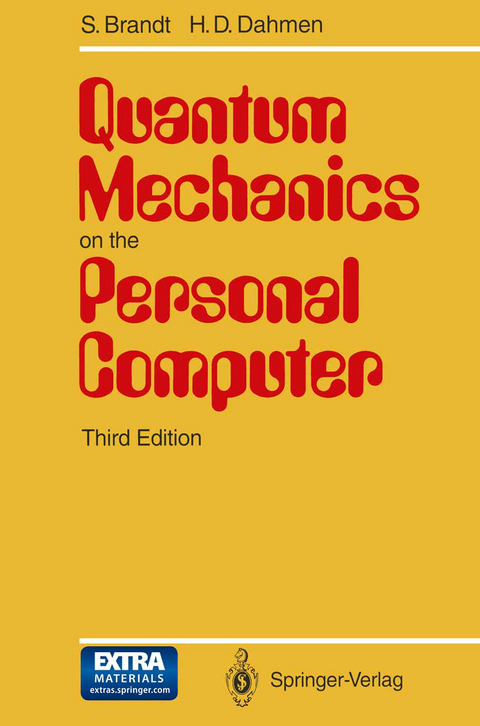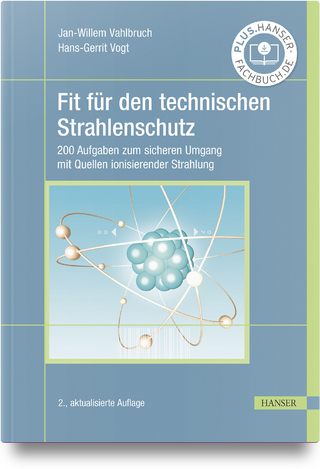
Quantum Mechanics on the Personal Computer
Springer Berlin (Verlag)
9783642786570 (ISBN)
Dr. Siegmund Brandt ist Professor für Physik an der Universität Siegen. Er arbeitet mit seiner Siegener Gruppe bei DESY und CERN an Experimenten zur Elementarteilchenphysik.
1. Introduction.- 1.1 Interquanta.- 1.2 The Structure of this Book.- 1.3 The Demonstrations.- 1.4 The Computer Laboratory.- 1.5 Literature.- 2. Free Particle Motion in One Dimension.- 2.1 Physical Concepts.- 2.2 A First Session with the Computer.- 2.3 The Time Development of a Gaussian Wave Packet.- 2.4 The Spectral Function of a Gaussian Wave Packet.- 2.5 The Wave Packet as a Sum of Harmonic Waves.- 2.6 Exercises.- 3. Bound States in One Dimension.- 3.1 Physical Concepts.- 3.2 Eigenstates in the Infinitely Deep Square-Well Potential and in the Harmonic-Oscillator Potential.- 3.3 Eigenstates in the Step Potential.- 3.4 Harmonic Particle Motion.- 3.5 Particle Motion in the Infinitely Deep Square-Well Potential.- 3.6 Exercises.- 4. Scattering in One Dimension.- 4.1 Physical Concepts.- 4.2 Stationary Scattering States in the Step Potential.- 4.3 Scattering of a Harmonic Wave by the Step Potential.- 4.4 Scattering of a Wave Packet by the Step Potential.- 4.5 Transmission and Reflection. The Argand Diagram.- 4.6 Exercises.- 4.7 Analogies in Optics.- 4.8 Reflection and Refraction of Stationary Electromagnetic Waves.- 4.9 Reflection and Refraction of a Harmonic Light Wave.- 4.10 Scattering of a Wave Packet of Light.- 4.11 Transmission, Reflection and Argand Diagram for a Light Wave.- 4.12 Exercises.- 5. A Two-Particle System: Coupled Harmonic Oscillators.- 5.1 Physical Concepts.- 5.2 Stationary States.- 5.3 Time Dependence of Global Quantities.- 5.4 Joint Probability Densities.- 5.5 Marginal Distributions.- 5.6 Exercises.- 6. Free Particle Motion in Three Dimensions.- 6.1 Physical Concepts.- 6.2 The 3D Harmonic Plane Wave.- 6.3 The Plane Wave Decomposed into Spherical Waves.- 6.4 The 3D Gaussian Wave Packet.- 6.5 The Probability Ellipsoid.- 6.6 Angular-Momentum Decomposition of a Wave Packet.- 6.7 Exercises.- 7. Bound States in Three Dimensions.- 7.1 Physical Concepts.- 7.2 Radial Wave Functions in Simple Potentials.- 7.3 Radial Wave Functions in the Step Potential.- 7.4 Probability Densities.- 7.5 Harmonic Particle Motion.- 7.6 Exercises.- 8. Scattering in Three Dimensions.- 8.1 Physical Concepts.- 8.2 Radial Wave functions.- 8.3 Stationary Wave Functions and Scattered Waves.- 8.4 Differential Cross Sections.- 8.5 Scattering Amplitude. Phase Shift. Partial and Total Cross Sections.- 8.6 Exercises.- 9. Special Functions of Mathematical Physics.- 9.1 Basic Formulae.- 9.2 Hermite Polynomials.- 9.3 Eigenfunctions of the One-Dimensional Harmonic Oscillator.- 9.4 Legendre Polynomials and Associated Legendre functions.- 9.5 Spherical Harmonics.- 9.6 Bessel functions.- 9.7 Spherical Bessel functions.- 9.8 Laguerre Polynomials.- 9.9 Radial Eigenfunctions of the Harmonic Oscillator.- 9.10 Radial Eigenfunctions of the Hydrogen Atom.- 9.11 Simple Functions of a Complex Variable.- 9.12 Exercises.- 10. Additional Material and Hints for the Solution of Exercises.- 10.1 Units and Orders of Magnitude.- 10.2 Argand Diagrams and Unitarity for One-Dimensional Problems.- 10.3 Hints and Answers to the Exercises.- Appendix A. A Systematic Guide to IQ.- A.1 Dialog Between the User and IQ.- A.1.1 A Simple Example.- A.1.2 The General Form of Commands.- A.1.3 The Descriptor File.- A.1.4 The Descriptor (Record).- A.1.5 The PLOT Command.- A.1.6 The STOP Command.- A.1.7 HELP: The Commands HE and PH.- A.2 Coordinate Systems and Transformations.- A.2.1 The Different Coordinate Systems.- A.2.2 Defining the Transformations.- A.3 The Different Types of Plot.- A.3.1 Choosing a Plot Type: The Command CH.- A.3.2 Cartesian 3D Plots (Type 0 Plots).- A.3.3 Polar 3D Plots (Type 1 Plots).- A.3.4 2D Plots (Type 2 Plots).- A.3.5 3D Column Plots (Type 3 Plots).- A.3.6 Special 3D Plots (Type 10 Plots).- A.4 The Background in the Plots.- A.4.1 Boxes and Coordinate Axes: The Command BO.- A.4.2 Scales.- A.4.3 Arrows.- A.4.4 Text and Numbers.- A.4.5 Mathematical Symbols and Formulae.- A.5 Further Commands.- A.5.1 Line Styles.- A.5.2 Multiple Plots.- A.5.3 Combined Plots.- A.5.4 Using Different Plotting Devices.- A.5.5 The Different Running Modes.- A.5.6 Definition of Physical Variables: The Commands V0 to V9.- A.5.7 Reserved Commands.- Appendix B. How to Install IQ.- B.1 Hardware Requirements.- B.2 Operating-System Requirements.- B.3 Diskette Format.- B.4 Installation.- B.5 Reformatting IQ for Different Types of Diskette.- Appendix C. Lists of All Files Provided.- C.1 Command Files.- C.2 Program Files.- C.3 Descriptor Files for Examples and Exercises.- C.4 Command Input Files and Associated Descriptor Files for Demonstrations.- C.5 DataFiles.- C.6 HelpFiles.- Appendix D. Graphics Devices and Metafiles.- Index of IQ Commands.
| Erscheint lt. Verlag | 13.4.2014 |
|---|---|
| Zusatzinfo | XIII, 314 p. 3 illus. |
| Verlagsort | Berlin |
| Sprache | englisch |
| Maße | 155 x 235 mm |
| Gewicht | 510 g |
| Themenwelt | Naturwissenschaften ► Chemie ► Physikalische Chemie |
| Naturwissenschaften ► Physik / Astronomie ► Quantenphysik | |
| Naturwissenschaften ► Physik / Astronomie ► Theoretische Physik | |
| Schlagworte | Computational Physics • Lehrsoftware • Quantenmechanik • quantum mechanics • Simulaltionsprogramm • Simulation Program • teaching software • theoretical physics • Theoretische Physik |
| ISBN-13 | 9783642786570 / 9783642786570 |
| Zustand | Neuware |
| Informationen gemäß Produktsicherheitsverordnung (GPSR) | |
| Haben Sie eine Frage zum Produkt? |
aus dem Bereich


